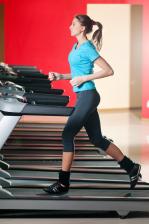How to Run Faster
Learn how to run faster and how to run longer without getting tired.
Ben Greenfield
Listen
How to Run Faster

Quick and Dirty Tip #1 for Running Faster: Lose Weight
Think about carrying a box of books up a flight of stairs. Compared with simply carrying your own body weight, the consequences of lifting 1, 5, or 10 extra pounds with each step can have you instantly huffing and puffing. Now imagine what happens when you carry 1, 5 or 10 extra pounds with each step you take during a 3 mile run. If you travel 3 feet with each stride, and cover about 15,000 feet during the run, you’re taking 5000 steps. If you lift your body 2 inches off the ground each time you step, that’s 10,000 inches, which means that if you’re just 5 pounds overweight, you had to generate over 4000 foot-pounds of extra force to get you through that run. So if you’re overweight and you’re going out and hammering every run workout, but not focusing on how to eat healthfully to achieve weight loss, you’re overworking your body. For more advice, I’d recommend you check out the article “What To Eat Before And After Exercise”. Having run competitively at 209 pounds and 170 pounds, I can tell you which running weight is better in terms of both speed and joint impact. (Obviously if you don’t have any weight to lose, this tip isn’t for you.)
Quick and Dirty Tip #2 for Running Faster: Increase Cadence
Aside from being skinny and being from high-altitude places, the fastest runners in the world have another defining characteristic: they take more steps per minute than the rest of us. In running terms, that means they have a higher cadence. Specifically, a cadence of 90 steps per minute is ideal. If you’re used to plodding along, this cadence will make you feel like you’re playing hot potato with your feet. Next time you’re running, count the number of steps you take in 20 seconds, with either your right or left foot. Now multiply by three. That number is your cadence. If you can take 30 steps in 20 seconds, then you’re on the right track to minimizing ground contact time and running faster.
Quick & Dirty Tip #3 for Running Faster: Use A Treadmill
Because that belt keeps moving underneath you no matter what you do, a treadmill is a great way to teach yourself to keep your cadence up and keep you moving forward. Like an indoor bicycle, there are fewer stops–such as stoplights and street crossings–so a treadmill can really help you focus more on the proper running form discussed in “How To Start Running”. During your training, try to include tempo runs, in which you set the treadmill at a slightly faster speed than you are comfortable with, and allow your legs to experience more rapid leg turnover. That trains the nerves and muscles in your legs to move faster.
Quick & Dirty Tip #4 for Running Faster: Run Hills
The best running coaches in the world know the deep, dark, and dirty secret of runners: hill training. The beauty of hills is that they allow you to achieve high intensities without the same amount of joint impact and pounding you’d experience while running on flat terrain. So by using hills regularly in your training, you both reduce your risk of injury and increase your intensity. For your long runs, attempt to regularly include courses that contain hills, and at least once every two weeks, attempt to include a hill sprint workout, in which you run up a steep hill at maximum sustainable pace for 30-60 seconds.
Quick & Dirty Tip #5 for Running Faster: Plyometrics
Plyometrics are explosive exercises like bounding, hopping and skipping. The benefit of these exercises is that they teach the elastic muscles of your legs and feet to quickly absorb your body weight and rebound from the ground. As a result, you minimize your ground contact time and maximize the distance you travel with each step. Even if you improve by just milliseconds per steps, over thousands of steps, that can be a huge speed boost. To avoid injury, plyometrics should not be a daily routine; just doing them once a week can provide enormous benefits.
Good plyometric exercises include hopping with one foot or both feet onto a raised surface like a step bench, performing explosive jumps from a lunge or squat position, or standing under a basketball hoop and repetitively tossing a ball against the backboard while jumping to retrieve it. For a video of one of my favorite plyometric exercises, Jumps Onto A Box, click here.
Run Faster By Being Consisent
The best way to become a faster runner is to ensure that your running routine is not constantly interrupted with sickness, vacation time, injuries, or business. Running every 48-72 hours keeps your muscles prepared for the unique movements of the running gait. On mornings where you’d be tempted to sleep in, slumber in your running tights with your shoes beside the bed. Always toss your running shoes in your bag or backpack before leaving for work. Include running gear in your suitcase when packing for vacation, no matter how short it may seem (48 hour airport layovers happen!). And remind yourself on those super busy days that when it comes to consistency, a short 15-20 minute jaunt is better than nothing at all.
By losing weight, increasing your cadence, using a treadmill, running hills, performing plyometrics and incorporating consistency, you’ll be able to take your running to an entirely new level.
Running image from Shutterstock

